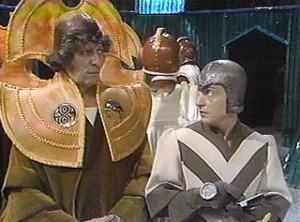I’ve been waiting for a story to explore the homeworld of the Time Lords, and finally here it is. Having received a call to return to Gallifrey, the Doctor has a premonition of the Time Lord president being assassinated, and tries to stop it, only to get caught up in the very plot itself.
This is a really well-written and well-envisioned story, and very different in style from the usual. It’s quite dark, dealing with themes of murder, survival, conspiracy and politics, and none of the four episodes feels wasted on anything frivolous. In fact, in a stark change of pace, episode 3 is a lone fight for survival as the Doctor tries to uncover the identity of the real killer inside a harsh virtual computer environment. It manages to show that Doctor Who can work without a companion narrating on events – it’s twenty minutes of an almost wordless cat and mouse game, in which the Doctor uses his many talents to survive and gain the upper hand.

A fight for survival inside the computer matrix, which conveniently takes the form of a forest and a quarry.
It’s also the surprising return of the Master, in a more horrific form. We learn that he has used up his twelve regenerations (first mention!) and is hanging onto dear life long enough to set up this assassination plot, with the intent of opening up the Eye of Harmony and saving himself, at the cost of destroying the Time Lords’ entire world. He’s not a charismatic character anymore, that’s for sure; he’s a grotesque monster, but as cunning and sharp as ever.
I do enjoy a bit of universe-building, and this serial is replete with information on the Time Lords’ history and culture. We also see just how different the Doctor is from his fellow brethren, rejecting formalities and continuing his juvenile tone. There are a couple of things I can take from this story: firstly, the Time Lords’ legal system is embarrassingly open to abuse; and secondly, the Doctor is not averse to killing when necessary. He does, after all, attempt to shoot the actual assassin at the ceremony (instead of getting the president away), and he fights Chancellor Goth to the death inside the computer matrix.
This is a real high point for Doctor Who, building up its lore while telling a compelling story, full of horror, intrigue and action. While I do wish the budget could have accommodated a larger scope (even just a matte painting of the capital city would have sufficed!), that’s something I can live without in this case. As for the Master, I was not surprised to see that he survives and escapes in his Tardis (shaped like a grandfather clock) at the end of the story, so no doubt he’ll return again soon.



